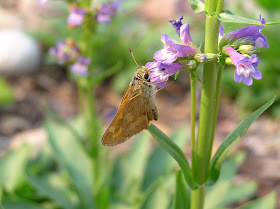 Here is a great new paper from Conservation Biology and a wonderful book for native plant gardeners Bringing nature home: how native plants sustain wildlife in our gardens by D. W. Tallamy .
Here is a great new paper from Conservation Biology and a wonderful book for native plant gardeners Bringing nature home: how native plants sustain wildlife in our gardens by D. W. Tallamy .Both share a common and inspiring theme (and a common author): native wildlife is tied to native plants and by gardening with native plants in your yard, you can have a beneficial effect on native wildlife. This sort of theme is refreshing, with invasive species, habitat loss, and climate change it is easy to get discouraged. But as the authors describes, you can make a difference in your backyard and it is just another reason for native plant gardening
In the paper, Impact of native plants on bird and butterfly biodiversity in suburban landscapes by Burghardt et al., the authors quantified the effect of landscaping with native plants vs. conventional landscaping on six paired properties (as small as 1/3 acre) in suburban Pennsylvania. The landscapes that used native plants had significantly more caterpillars and caterpillar species and significantly greater bird abundance, diversity, species richness, biomass, and breeding pairs of native species than the conventionally landscaped properties. The authors concluded that landscaping with native plats is an effective tool for promoting biodiversity in suburban or otherwise anthropogenic modified landscapes.
The book is equally hopeful. In Bringing Nature Home, the author explains the power gardeners have in improving biodiversity and providing homes for native wildlife, as habitat loss continues elsewhere. The author thoughtfully and thoroughly explains the intimate relationship between native plants and their native host insects. When native plants get replaced by exotic species, you lose native insects and ultimately the birds and other animals that depend on these insects for food. However, as the author describes, by incorporating native plants into your landscape you can reverse this trend, and he provides many examples and explanations on how to garden with natives.
No comments:
Post a Comment